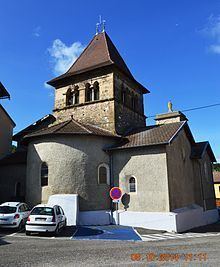Area 14.15 km² | Intercommunality Région Saint-Jeannaise | |
 | ||
Artas (Occitan: Artàs) is a French commune in the Isère department in the Auvergne-Rhône-Alpes region of south-eastern France.
Contents
Map of 38440 Artas, France
The inhabitants of the commune are known as Artasiens or Artasiennes
Geography
Artas is located some 20 km east by north-east of Vienne and some 8 km south of Villefontaine. Access to the commune is by the D53 road from Charantonnay in the west passing through the heart of the commune and the village and continuing to Saint-Agnin-sur-Bion in the east. The D126 road comes from Roche in the north through the heart of the commune and crossing the D53 in the village before continuing to Saint-Jean-de-Bournay in the south. Apart from the village there are also the hamlets of Le Barroz, Le Revolet, Cinquin, Radoire, Tarnezieux, and La Petite-Foret. The commune is mainly farmland with scattered forests throughout.
The Ruisseau de Charavoux rises in the west of the commune and flows west to join the Ambalon near Chasse-sur-Rhône.
History
In the reign of Louis XIV the Oak trees from the Artas Forest provided a large part of the wood needed to build the King's Galleys at Marseille.
Artas was the birthplace of Mother's Day in France on 10 June 1906 - two years earlier than the date of origin of 1908 claimed by the USA.
Administration
List of Successive Mayors
(Not all data is known)
Demography
In 2010 the commune had 1,620 inhabitants. The evolution of the number of inhabitants is known from the population censuses conducted in the commune since 1793. From the 21st century, a census of communes with fewer than 10,000 inhabitants is held every five years, unlike larger towns that have a sample survey every year.
Sources : Ldh/EHESS/Cassini until 1962, INSEE database from 1968 (population without double counting and municipal population from 2006)
